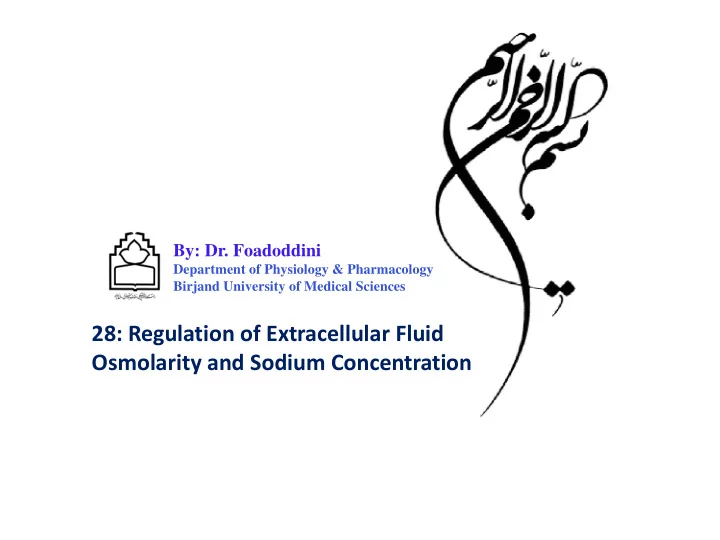

By: Dr. Foadoddini Department of Physiology & Pharmacology Birjand University of Medical Sciences 28: Regulation of Extracellular Fluid Osmolarity and Sodium Concentration
0.5 20 L 50 1200 mOsmol/L
Countercurrent Mechanism • Interaction between the flow of filtrate through the loop of Henle (countercurrent multiplier) and the flow of blood through the vasa recta blood vessels (countercurrent exchanger) The solute concentration in the loop of Henle ranges from 300 mOsm to • 1200 mOsm
Countercurrent Mechanism Produces a Hyperosmotic Renal Medullary Interstitium http://www.colorado.edu/intphys/Class/IPHY3430-200/countercurrent_ct.html http://www.cellphys.ubc.ca/undergrad_files/urine.swf http://bio-alive.com/animations/anatomy.htm
Urea Contributes to Hyperosmotic Renal Medullary Interstitium and to a Concentrated Urine Permeable to H2O if ADH 50%
Countercurrent Exchange in the Vasa Recta Preserves Hyperosmolarity of the Renal Medulla
Countercurrent Multiplier and Exchange • Medullary osmotic gradient • H 2 O → ECF → vasa recta vessels
Quantifying Renal Urine Concentration and Dilution: "Free Water" and Osmolar Clearances 2.1 * 142 = 298 mOsmol/L
29: Renal Regulation of Potassium, Calcium, Phosphate, and Magnesium; Integration of Renal Mechanisms for Control of Blood Volume and Extracellular Fluid Volume
Pressure Diuresis & Natriuresis importance in BV and ECF control Directly UO BP Indirectly
Pressure Natriuresis and Diuresis Are Key Components of a Renal ‐ Body Fluid Feedback for Regulating Body Fluid Volumes and Arterial Pressure
BV BP UO CO
Factors Increase the Effectiveness of Renal-Body Fluid Feedback Control � Neural control � AgII � Aldostrone � ADH � ANP
Factors affect K secretion: [K]o Aldostrone Tubular flow Acidosis
30: Regulation of Acid ‐ Base Balance
extremely low pH: is not linear but logarithmic function ie, more change in acidemia normal range of arterial pH: 7.37 to 7.42 Volatile acids: CO2 carbonic anhydrase Non ‐ Volatile acids: H2SO4, H3PO4 β‐ hydroxybutyric acid, Acetoacetic acid Lactic acid Salcylic acid, formic acid Gycolic acid, oxalic acid
Isohydric law
Acetazolamide brush border carbonic anhydrase 2 1 5 4 3 no net secretion of H + little change in tubular fluid pH
DT, CT
Acid-base nomogram
Micturition (Voiding or Urination) • Bladder can hold 250 ‐ 400ml • Greater volumes stretch bladder walls initiates micturation reflex: • Spinal reflex – Parasympathetic stimulation causes bladder to contract – Internal sphincter opens – External sphincter relaxes due to inhibition
Urination: Micturation reflex Figure 19-18: The micturition reflex
Micturition (Voiding or Urination) Figure 25.20a, b
Recommend
More recommend